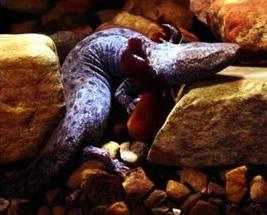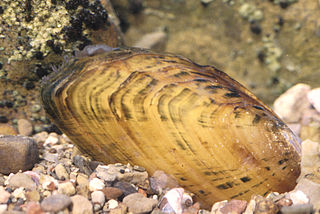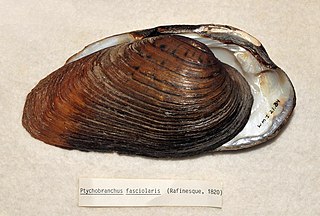The Sydenham River is a river in Chatham-Kent, Lambton County and Middlesex County in southwestern Ontario, Canada, flowing southwest from its source west of London, Ontario and emptying into Lake Saint Clair. The length of the river is 165 kilometres (103 mi) and it drains a watershed of approximately 2,700 square kilometres (1,000 sq mi). The river flows through the towns of Strathroy and Wallaceburg. It was named after Lord Sydenham, governor of Canada from 1839 to 1841.

The common mudpuppy is a species of salamander in the family Proteidae. It lives an entirely aquatic lifestyle in parts of North America in lakes, rivers, and ponds. It goes through paedomorphosis and retains it external gills. Because skin and lung respiration alone is not sufficient for gas exchange, the common mudpuppy must rely on external gills as its primary means of gas exchange. It is usually a rusty brown color and can grow to an average total length of 13 in (330 mm). It is a nocturnal creature, and is active during the day only if the water in which it lives is murky. Its diet consists of almost anything it can get into its mouth, including insects, mollusks, and earthworms. Once a female common mudpuppy reaches sexual maturity at six years of age, she can lay an average of 60 eggs. In the wild, the average lifespan of a common mudpuppy is 11 years.

The dwarf wedgemussel is an endangered species of freshwater mussel, an aquatic bivalve mollusk in the family Unionidae, the river mussels.

The northern riffleshell is a subspecies of freshwater mussel, an aquatic bivalve mollusk in the family Unionidae, the river mussels. This mussel is endangered and federally protected. It was proposed as a species, Epioblasma rangiana, by Williams et al. (2017).

The fauna of Canada consist of approximately 200 mammal species, over 460 native bird species, 43 amphibian species, 43 reptile species, and 1,200 fish species. The biology survey of Canada cites that there are approximately 55,000 species of insects, and 11,000 species of mites and spiders.

The freshwater pearl mussel is an endangered species of freshwater mussel, an aquatic bivalve mollusc in the family Margaritiferidae.

The cracking pearlymussel is an endangered species of freshwater mussel, an aquatic bivalve mollusk in the family Unionidae.

The brook floater or swollen wedgemussel, Alasmidonta varicosa, is a species of freshwater mussel, an aquatic bivalve mollusk in the family Unionidae, the river mussels. It measures 25.1 mm to 80.2 mm in length although other research also suggests it rarely exceeds three inches (75 mm).

Cumberlandia monodonta is a freshwater mussel endemic to the United States. Currently, C. monodonta is listed as an endangered species by the U.S. Fish and Wildlife Service and the International Union for Conservation of Nature.
The Chipola slabshell is a part of the phylum Mollusca and the class Bivalvia. This species has suffered a large decrease with upwards of 75% of habitat lost. It is now confined to only a few remnant sites in small drainages within the Chipola River. The federal Endangered Species Act protects it as a designated threatened species by Florida's Endangered and Threatened Species Rule.

Epioblasma brevidens, the Cumberlandian combshell, is a species of freshwater mussel, an aquatic bivalve mollusk in the family Unionidae. This species is endemic to the United States, found mainly in the states of Tennessee and Virginia. This mussel resides in medium-sized streams to large rivers. The combshell is an endangered species and protected under the Endangered Species Act of 1973. The combshell is threatened by habitat modifications and pollution.

Fusconaia escambia, the narrow pigtoe, is a freshwater bivalve mussel found in Alabama and northwestern Florida. The narrow pigtoe was first discovered in the Escambia River in Alabama and Florida.

Lampsilis cariosa, the yellow lampmussel, is a species of freshwater mussel, an aquatic bivalve mollusk in the family Unionidae, the river mussels.

Sagittunio nasutus, the eastern pondmussel, is a species of freshwater mussel in the family Unionidae, the river mussels.

Obovaria retusa is a rare species of freshwater mussel in the family Unionidae, the river mussels. Its common names include golf stick pearly mussel

Obovaria subrotunda, common name the round hickorynut, is a species of freshwater mussel, an aquatic bivalve mollusk in the family Unionidae, the river mussels.

Ptychobranchus fasciolaris is a species of freshwater mussel in the family Unionidae, the river mussels. Its common name is kidneyshell.

Quadrula quadrula, the mapleleaf, is a species of freshwater mussel, an aquatic bivalve mollusk in the family Unionidae, the river mussels.

Epioblasma triquetra, common name the snuffbox mussel, is a species of freshwater mussel, a mollusk in the family Unionidae. It is native to eastern North America, where it is a listed as an endangered species in both Canada and the United States.

Gonidea angulata, the western ridged mussel or Rocky Mountain ridged mussel, is a species of freshwater mussel, an aquatic bivalve mollusk in the family Unionidae, the river mussels. It is the only species in the genus Gonidea.



















